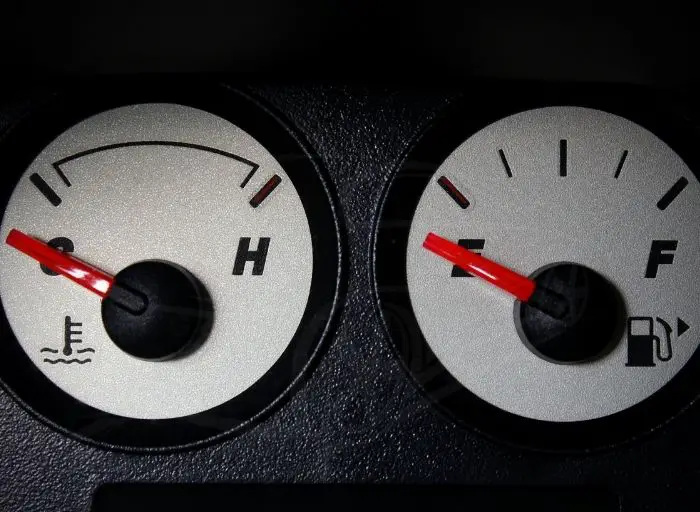
If you notice the temperature gauge on your dashboard fluctuates up and down while driving, it’s likely an issue with the car. Before heading to a mechanic, let’s see what causes the temp gauge goes up and down while driving and if there is anything you can do about it.
Table of Contents
What Is Temperature Gauge?
A temperature gauge is an instrument attached to the dashboard of your vehicle. It measures the amount of heat emanating from the engine.
Now, why do you need to know the temp gauge inside your vehicle? It is because coolant fluid keeps your vehicle engine running cool and comfortable. If you have a faulty temperature gauge, your engine begins to overheat, then steam is released into the air which can be dangerous for you and everyone else who gets close to it.
What Causes Car Temp Gauge Goes Up and Down While Driving
When people notice the temperature gauge goes up and down while driving, the reason is because something is not working properly in your car’s cooling system. Below are the most common ones:
1. Control Valve
Your engine has a control valve that regulates the amount of coolant it allows into the engine. These components can become worn out over time and need to be replaced. If the control valve is weak, then it can leak without you even noticing. In this case, you’ll see steam coming from the cooling system of your vehicle since there is no coolant in there to keep it from overheating.
2. Thermostat
The thermostat is responsible for regulating the temperature of the engine. It controls the amount of coolant that enters the cylinder and keeps it from overheating. If your thermostat becomes worn out, then it may start to leak and block your cooling system. When a stuck-closed thermostat happens, you’ll start seeing steam coming from your engine internals since there’s no way to get coolant into them anymore. The only fix for this is a new thermostat and replacement of other related components that rely on it.
3. Overheating Engine
A vehicle’s engine can overheat because there’s something wrong with it. The coolant can be affected by other parts that are worn out or there could be a problem with the thermostat. At this point, you’ll need to pay for a replacement for the entire engine instead of just dealing with your temperature gauge going up and down while driving.
4. Radiator Issues

The radiator aims to keep your vehicle cool by producing coolant. It can be blocked by debris or not properly secured, which will cause it to leak and put the entire engine at risk of overheating. If any of its components are at fault, they can cause the temp gauge to fluctuate as well.
- Radiator Cap: Your radiator has a cap that regulates the amount of coolant inside it. If this cap is weak, then it may come loose and cause your temperature gauge to fluctuate.
- Faulty Radiator Fans: The fans inside your radiator are responsible for spreading the coolant throughout the engine. If they are faulty or not working, then it can cause your temperature gauge to go up and down while driving.
- Faulty Radiator Hoses: There are several hoses connected to the radiator that are responsible for carrying coolant toward the engine properly. If one of these hoses becomes weak or damaged, then your temperature gauge is likely to go up and down when you drive.
5. Not Enough Coolant Liquid
Your engine needs a certain amount of coolant liquid to run comfortably. If there’s not enough coolant in the radiator, then the engine will overheat and your temp gauge will show erratic numbers on the dash.
You can find the coolant container by raising the hood. It is a plastic bottle with a steam warning mark on the cap. Additionally, it features a min/max gauge and coolant marks on the side. The liquid inside will be blue, green, or red and smell like antifreeze if you are not running it on water.
Open the cap and add more coolant if the level has fallen below the minimum. Antifreeze colors shouldn’t be mixed up, but brands can be. Demineralized or distilled water is preferable if you want to add water because it is particle-free.
The coolant will explode under pressure in a cloud of smoke and scalding liquid when it is hot, which is why there is a steam warning. This can result in severe burns. Never remove the coolant cap from the engine until you are positive that it has cooled down enough; even then, cover it with a piece of cloth to add an extra layer of safety.

Compared to antifreeze, water has lower boiling and higher freezing temperatures. Water will have a tiny window of time before it overheats because most cars operate at temperatures between 180 and 220 degrees Fahrenheit. It becomes significantly more problematic in the winter. When water freezes, it expands and becomes strong enough to fracture engine blocks, rupture water pumps, and burst pipelines.
It is strongly advised to use an antifreeze/distilled water mixture of 50% each. If you need to add more coolant while driving, you can use water; just make sure to check the coolant’s temperature tolerances using an antifreeze tester before winter.
6. Faulty Water Pump
The water pump is responsible for circulating coolant through the engine. If it fails, then the coolant will not reach the engine. This can cause your temp gauge to go up and down while driving.
Jeep Temperature Gauge Goes up And Down
If you wonder why your jeep temperature gauge goes up and down as you drive, the reasons are no different from what I mentioned above. However, this is not a common issue for jeep owners.
You can check out this video for a quick fix:
How to Fix a Temperature Gauge Going Up and Down
If the temperature gauge on your automobile isn’t working, it’s time to look into the problem. If you do find the defective component, act quickly to correct the problem. Your car may suffer catastrophic damage if you put off repairs. Here are several straightforward and doable fixes for these mechanical issues, along with a bucket to empty the coolant.
Changing a Faulty Thermostat Valve

As was already established, the thermostat is a cheap auto component that, if it develops a malfunction, can be the end of a car if it is not replaced properly. Here is a fast remedy for a broken thermostat. Before completing the procedures below, you are urged to obtain the necessary tools. A screw jack, a set of vice grips, various-sized screwdrivers, an adjustable wrench, an OBDII scanner, a pocket knife, and a tiny ball-peen hammer are among the items.
- After stopping your automobile, let it a good 15 minutes to cool off.
- Find the thermostat valve’s location. It is often located at the bottom or top of the radiator of the car.
- To give yourself more clearance, jack up your vehicle.
- Remove the radiator’s cap.
- Remove the thermostat safely and drain the radiator.
- Verify the thermostat’s continued operation. Check to see if it opens by putting it in a bowl of boiling water. If it stays close, it is no longer effective.
- Put a new thermostat in place of the damaged one. Before replacing, verify that all of your coolant plugs are in good condition.
- Start the engine to see if the temperature gauge on the car has changed noticeably.
A Faulty Coolant Temperature Sensor Replacement
Typically, the coolant temperature sensor (CTS) is situated close to the radiator’s base. A damaged coolant temperature sensor is one typical reason for inaccurate temperature readings (CTS). When the CTS is harmed, the car develops engine knocking. Engine knocking occurs when fuel burns unevenly in the cylinder, causing pre-ignition to produce shocks and noise.
Replacement of a defective temperature sensor typically costs between $145 and $195. The cost of the part and the labor are both included in the fee. However, you should budget between $65 and $90 if you want to get a replacement sensor.

The actions listed below must be followed in order to fix a bad CTS.
- You can check the sensor’s condition using a reliable OBD2 scanner to make sure it is still functional.
- Give your car 20 minutes to cool down if the CTS isn’t working.
- Jack up the car’s front side for improved clearance.
- Take off the radiator cap.
- Radiator coolant and water should be drained.
- Make sure the CTS wiring connector is unplugged.
- Continue by removing the defective temperature sensor.
- Replacement of the temperature sensor.
- Reconnect the wiring connector after that.
- Start your engine to test the gauge’s functionality.
FAQs
#1 Is it safe to drive if my car’s temperature gauge is fluctuating?
No, it is not safe to drive if your car’s temperature gauge is fluctuating. Fluctuations in the temperature gauge may indicate a problem with the engine’s cooling system, which could lead to overheating and serious damage to the engine if not addressed promptly. It is best to pull over and have the car inspected by a professional mechanic to identify and fix the problem before continuing to drive.
#2 What should I check if my car’s temperature gauge is going up and down?
If your car’s temperature gauge is going up and down, it could indicate a problem with the engine’s cooling system. Here are a few things you can check:
- Coolant level: Check the coolant level in the radiator and make sure it’s at the appropriate level. If it’s low, it could cause the engine to overheat, which could be the reason for the fluctuations.
- Radiator cap: Check the radiator cap for any signs of damage, such as cracks or leaks. A faulty radiator cap can cause fluctuations in the temperature gauge.
- Thermostat: The thermostat regulates the flow of coolant through the engine. If it’s faulty, it could cause the engine to overheat and lead to fluctuations in the temperature gauge.
- Water pump: The water pump circulates coolant through the engine. If it’s not working properly, it could cause the engine to overheat and result in fluctuations in the temperature gauge.
#3 What is the most likely cause of my car’s temperature gauge fluctuating?
The most likely cause of a car’s temperature gauge fluctuating is a problem with the engine’s cooling system. This could be caused by a variety of issues, such as a low coolant level, a malfunctioning thermostat, a faulty water pump, or a blocked radiator. A damaged or worn-out radiator cap can also cause fluctuations in the temperature gauge.
Conclusion on Fluctuating Temperature Gauge
The temperature indicator on your car might be amusing you because it changes unpredictably. Poor radiator performance, a broken water pump, leaks in the coolant level, and a malfunctioning thermostat are common causes of this inconsistency. A burst head gasket can also be the main offender.
If you observe that the temperature of your automobile fluctuates, you must repair any defective parts as quickly as you can to prevent further harm to the engine. The appropriate tools can be used to replace them.
Further Reading:
Hi there! I’m Naomi O’Colman. I’ve got years of experience working at an auto repair shop here in Texas under my belt. On top of that, ever since I was a kid I’ve been passionate about the auto industry. Since I’ve joined the team at automotivegearz.com I’ve been enthusiastically sharing my passion and insights with my readers. I’m dedicated to delivering high quality content and helping you stay up to date with the latest automotive trends and products out there!







